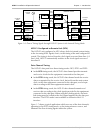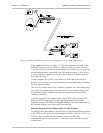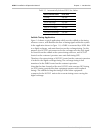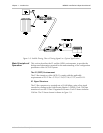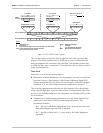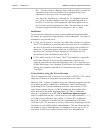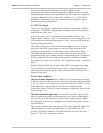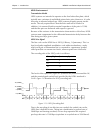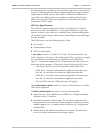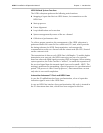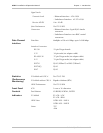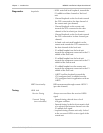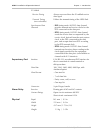
HCD-E1 Installation & Operation Manual Chapter 1 - Introduction
01/01/01 08:07 Functional Description 1-21
By reducing the line symbol rate, the maximum range that can be reached is
increased. Together with the advanced digital signal processing techniques
implemented in HDSL systems, this results in a robust data transmission
system that can reliably operate over regular unconditioned local loops,
while exceeding several times the ranges that can be achieved by direct
transmission of an E1 signal.
HDSL Line Signal Structure
The HDSL line signal is organized in frames. Each frame has a nominal
duration of 6 msec: this translates to 3504 quats (7008 bits) for two-loop
systems. However, due to the use of stuffing, frames without stuffing quats
are actually one quat shorter, while frames with stuffing are one quat longer
than the nominal.
The HDSL frames carry the following types of data:
•
Core frames
•
Synchronization words
•
HDSL overhead quats
A core frame consists of 144 bytes (1152 bits). The structure of the core
frames depends on the type of data being carried. The core frames are split,
on a per byte basis, for transmission in parallel over the HDSL lines.
Figure 1-11 shows the mapping of the 32 application time slots of the core
frame into the two groups of 18 time slots carried by the two HDSL lines:
− Time slots 0 and 16 are carried in parallel on both HDSL lines.
− HDSL line 1 carries the odd-numbered application time slots up to
time slot 16, and then even-numbered application time slots.
− HDSL line 2 carries the even-numbered application time slots up to
time slot 16, and then odd-numbered application time slots.
− The last HDSL time slot is filled with ones (AIS signal).
The synchronization word consists of 7 quats, and its function is to enable
HDSL frame alignment.
16 HDSL overhead quats are used to carry the following data:
•
Indications such as far-end block error (FEBE), loss of signal and bipolar
violations on the E1 interface.
•
Embedded operations channel (eoc). The eoc allows supervision and
management of system operation (status, diagnostic loopbacks and tests,
repeater support, etc.) or vendor-defined functions (e.g., configuration
downloading).
•
Identification of the HDSL line number (seven quats). This allows the
receiver to detect unintentional interchange of pairs.



